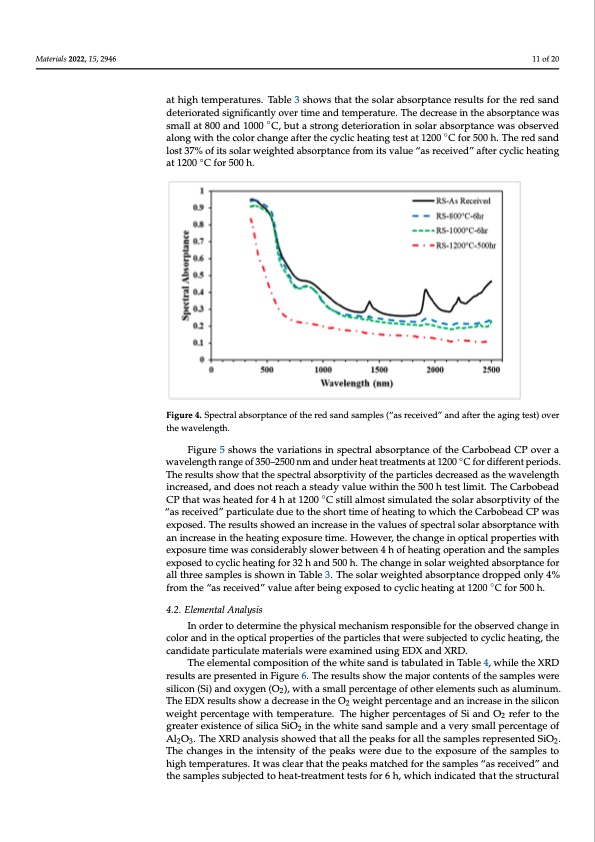
PDF Publication Title:
Text from PDF Page: 011
Materials 2022, 15, 2946 11 of 20 at high temperatures. Table 3 shows that the solar absorptance results for the red sand deteriorated significantly over time and temperature. The decrease in the absorptance was small at 800 and 1000 ◦C, but a strong deterioration in solar absorptance was observed along with the color change after the cyclic heating test at 1200 ◦C for 500 h. The red sand Materials 2022, 15, x FOR PEER REVIEW 13 of 23 lost 37% of its solar weighted absorptance from its value “as received” after cyclic heating at 1200 ◦C for 500 h. Figure 4. Spectral absorptance of the red sand samples (“as received” and after the aging test) over Figure 4. Spectral absorptance of the red sand samples (“as received” and after the aging test) over the wavelength. the wavelength. Error! Reference source not found. shows the variations in spectral absorptance of Figure 5 shows the variations in spectral absorptance of the Carbobead CP over a ◦ the Carbobead CP over a wavelength range of 350–2500 nm and under heat treatments at wavelengthrangeof350–2500nmandunderheattreatmentsat1200 Cfordifferentperiods. 1200 °C for different periods. The results show that the spectral absorptivity of the parti- The results show that the spectral absorptivity of the particles decreased as the wavelength icnlcersedaseecdre,asneddasoethsenwotarveealcehngathstienacdryeavsaeldu,eawnditdhionesthneo5t0re0ahchteaststleimadity.vTahleueCwaribthoibneathde ◦ “tahseresocelaivreadb”sopraprtivcuitlyatoefdthue“toasthrecsehiovretdt”impearotifchuelateindguteotwohtihcehsthoerCtatirmboeboefahdeCatPinwgatso ewxphoicshedth. eThCearebsoubletsadshCoPwewdaasnexinpcorseeads.eTinhethresvualltuseshofwsepdecatrnalinscorleaarsaebisnortphteanvaceluwesitohf asnpeinctcraelaseolianrtahbeshoerpatiangcexwpiothsuarnetiinmcree.aHseowinevtheer,htheeatcinhganegxepionsuorpetitciamlep.roHpoewrteievserw,itthe ecxhpaonsguereintiompetiwcalspcronpseidrteierasbwlyitshloewxpeor sbuertewteiemne4whaosfchoenastiidnegraobpleyrastloiownearnbdetwheesanm4phleosf ehxepaotsinedgotopecryactliocnheaantdintghefosram32phleasnedxp5o0s0ehd.tTohceyclhiacnhgeeatiingsofloar3w2ehigahntded50a0bhso.rTphteanchceanfogre C5P00thatteswtalismhiet.aTtehdeCfoarr4bohbaetad12C0P0thCatstwilalsalhmeaotsetdsifmoru4lahteadt1t2h0e0s°oClasrtiallbaslomrpotsitvsiitmyouflattheed ailnltshorleaerwsaemigphlteesdisasbhsorwpntainceTafbolrea3ll.tThhreesosalamrpwlesigihstsehdoawbnsoirnpEtarnrocre!dRreofpeprendcoensloyu4r%ce ◦ fnromt ftohuen“da.s. rTehceivseodla”rvwaleuigehatfetedr abbesinogrpetxapnocesedrtopcpyecdlicohnelyati4n%g afrto1m200theC“faosr r5e0c0ehiv.ed” value after being exposed to cyclic heating at 1200 °C for 500 h. 4.2. Elemental Analysis In order to determine the physical mechanism responsible for the observed change in color and in the optical properties of the particles that were subjected to cyclic heating, the candidate particulate materials were examined using EDX and XRD. The elemental composition of the white sand is tabulated in Table 4, while the XRD results are presented in Figure 6. The results show the major contents of the samples were silicon (Si) and oxygen (O2), with a small percentage of other elements such as aluminum. The EDX results show a decrease in the O2 weight percentage and an increase in the silicon weight percentage with temperature. The higher percentages of Si and O2 refer to the greater existence of silica SiO2 in the white sand sample and a very small percentage of Al2O3. The XRD analysis showed that all the peaks for all the samples represented SiO2. The changes in the intensity of the peaks were due to the exposure of the samples to high temperatures. It was clear that the peaks matched for the samples “as received” and the samples subjected to heat-treatment tests for 6 h, which indicated that the structuralPDF Image | Low-Cost Particulates Used as Energy Storage and Heat-Transfer Medium

PDF Search Title:
Low-Cost Particulates Used as Energy Storage and Heat-Transfer MediumOriginal File Name Searched:
materials-15-02946.pdfDIY PDF Search: Google It | Yahoo | Bing
Turbine and System Plans CAD CAM: Special for this month, any plans are $10,000 for complete Cad/Cam blueprints. License is for one build. Try before you buy a production license. More Info
Waste Heat Power Technology: Organic Rankine Cycle uses waste heat to make electricity, shaft horsepower and cooling. More Info
All Turbine and System Products: Infinity Turbine ORD systems, turbine generator sets, build plans and more to use your waste heat from 30C to 100C. More Info
CO2 Phase Change Demonstrator: CO2 goes supercritical at 30 C. This is a experimental platform which you can use to demonstrate phase change with low heat. Includes integration area for small CO2 turbine, static generator, and more. This can also be used for a GTL Gas to Liquids experimental platform. More Info
Introducing the Infinity Turbine Products Infinity Turbine develops and builds systems for making power from waste heat. It also is working on innovative strategies for storing, making, and deploying energy. More Info
Need Strategy? Use our Consulting and analyst services Infinity Turbine LLC is pleased to announce its consulting and analyst services. We have worked in the renewable energy industry as a researcher, developing sales and markets, along with may inventions and innovations. More Info
Made in USA with Global Energy Millennial Web Engine These pages were made with the Global Energy Web PDF Engine using Filemaker (Claris) software.
Sand Battery Sand and Paraffin for TES Thermo Energy Storage More Info
| CONTACT TEL: 608-238-6001 Email: greg@infinityturbine.com | RSS | AMP |